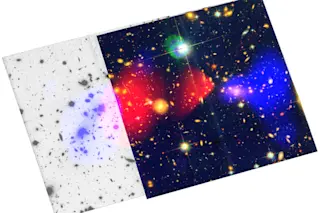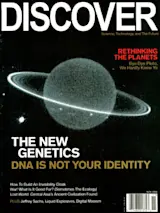Most of the universe, it may surprise you to know, is invisible. About 80 percent of all matter is "dark," emitting no light and interacting with normal matter only through gravity.Or that's what physicists have long suspected, without direct proof. Then two massive colliding galaxy clusters in the constellation Carina caught the attention of Marusa Bradac of the Kavli Institute at Stanford University and her colleagues, who saw this cosmic smashup as a chance to watch dark matter in action.
Bradac and her colleagues compared X-ray pictures of visible matter in the clusters with measurements of their total mass. As the clusters collided, the visible matter (red) appeared to be kicked out of alignment with the overall mass (blue). If dark matter didn't exist, the separation in the image couldn't occur. "The visible matter gets stuck there, whereas the dark matter goes through unaffected," she says.
Until now, the best evidence for dark matter was that orbital speeds of stars in a galaxy do not fall off with increasing distance from the galaxy's center, as would seem to be necessary to keep the stars from flying off into space. The fact that the galaxies hold together suggests that unseen mass provides the gravity to hold them together. Some researchers have sought to explain the steady orbital speed with alternative theories of gravity, but it is unlikely that anything other than dark matter can explain the new observations. "It's pretty conclusive," Bradac says.
Meanwhile, particle physicists are trying to detect dark matter on Earth. "There are dark-matter particles around you and me right now," Bradac says. "It's likely they will be detected in the next five years."















